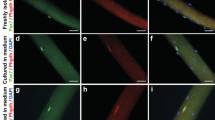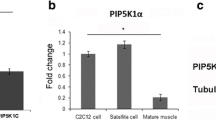Abstract
We analysed the signaling pathways involved in myogenic differentiation of primary cultures of rat satellite cells using substances targeting the protein kinase C (PKC) and the cAMP protein kinase (PKA) pathways. We have previously shown that iso-H7, which putatively inhibits both PKC and PKA, strongly stimulates satellite cell differentiation, as well as the PKA inhibitor HA 1004. In the study reported here, the effects of iso-H7 on satellite cell differentation were compared to those observed in the presence of agents which reduce PKC activity. It was shown that treatments with the highly specific PKC inhibitor GF109203X or with 12-O-tetradecanoylphorbol 13-acetate (TPA) which induced a partial PKC downregulation, did not significantly alter myogenic differentiation. Northern blot analyses showed that iso-H7 activated the expression of myogenin but not that of MyoD mRNA. Concurrently, iso-H7 increased myosin light-chain mRNA expression. In contrast, TPA had no effect on these syntheses. Taken together, these results showed that iso-H7 did not act intracellularly as a PKC inhibitor but rather as a PKA inhibitor as previously suggested. Our results are compatible with the hypothesis that a reduction in PKA activity controls satellite cell myogenesis through an increased myogenin mRNA expression.
Similar content being viewed by others
Abbreviations
- PKC:
-
protein kinase C
- PKA:
-
cAMP-dependent protein kinase
- CK:
-
creatine kinase
- iso-H7:
-
1-(5-isoquinolinesulfonyl)-3-methylpiperazine
- H7:
-
1-(5-isoquinolinesulfonyl)-2-methylpiperazine
- HA 1004:
-
N-(3-hydroxyethyl)-1-piperazine ethanesulfonate
- TPA:
-
12-O-tetradecanoyl phorbol 13-acetate
- MLC:
-
myosin light chain
- GAPDH:
-
glyceraldehyde 3-phosphate deshydrogenase
References
Alterio J, Courtois Y, Robelin J, Bechet D, Martelly I. Acidic and basic fibroblast growth factor mRNAs are expressed by skeletal muscle satellite cells. Biochem Biophys Res Commun. 1990;166:1205–12.
Braun T, Rudnicki MA, Arnold HH, Jaenish R. Targeted inactivation of muscle regulatory gene myf-5 results in abnormal development and perinatal death. Cell. 1992;71:369–82.
Castagna M, Takay Y, Kaibuchi K, Sano K, Kikkawa U, Nishizuka Y. Direct activation of calcium-activated phospholipid-dependent protein kinase by tumor promoting phorbol esters. J Biol Chem. 1982;257:7847–51.
Chomczynski P, Sacchi A. Single-step method of RNA isolation by acid guanidium thiocyanate-phenol-chloroform extraction. Anal Biochem. 1987;162:156–9.
Cossu G, Molinaro M, Pacifici M. Differential response of satellite cells and embryonic myoblasts to a tumor promoter. Dev Biol. 1983;98:520–4.
Davis RL, Weintraub H, Lassar AB. Expression of a single transfected cDNA converts fibroblasts to myoblasts. Cell. 1987;51:987–1000.
Fort P, Piechaczyk M, Sabrouty S, El Dani C, Janteur P, Blanchard JM. Various rat adult tissues express only one major mRNA species from glyceraldehyde-3-phosphate deshydrogenase multigenic family. Nucleic Acids Res. 1985;13:1431–42.
Garfinkel LF, Periasamy M, Nadal-Ginard B. Cloning and characterization of cDNA sequences corresponding to myosin light chains 1, 2, and 3, troponin C, α-tropomyosin and α-actin. J Biol Chem. 1982;257:11078–86.
Hagiwara M, Alberts A, Brindle P et al. Transcriptional attenuation following cAMP induction requires PP-1-mediated dephosphorylation of CREB. Cell. 1992;70:105–13.
Hasty P, Bradley A, Morris J et al. Muscle deficiency and neonatal death in mice with targeted mutation in the myogenin gene. Nature. 1993;364:501–6.
Hu JS, Olsen EN. Regulation of differentiation of the BC3H1 muscle cell line through cAMP-dependent and-independent pathways. J Biol Chem. 1988;263:19670–7.
Kim HS, Chung CH, Kang MS, Ha DB. Okadaic acid blocks membrane fusion of chick embryonic myoblasts in culture. Biochem Biophys Res Commun. 1991;176:1044–50.
Kim SJ, Kim KY, Tapscott SJ et al. Inhibition of protein phosphatases blocks myogenesis by first altering MyoD binding activity. J Biol Chem. 1992;267:15140–5.
Lagord C, Carpentier G, Moraczewski J, Pons G, Climent F, Martelly I. Satellite cell myogenesis is highly stimulated by the kinase inhibitor iso-H7: comparison with HA 1004 and staurosporine effects. Biochem Biophys Res Commun. 1993a;191:928–36.
Lagord C, Carpentier G, Leibovitch MP, Gautron J, Martelly I. Stimulation of rat satellite cell myogenesis by inhibitors of ser/thr protein kinases. Neuromusc Disord. 1993b;3:379–83.
Lagord C, Moraczewski G, Leibovitch MP, Castagna M, Martelly I (1996) submitted.
Lassalle B, Le Moigne A, Martelly I, Gautron J. Image analysis of rat satellite cell proliferation in vitro. Cytotechnology. 1989;2:209–24.
Leibovitch SA, Lenormand JL, Leibovitch MP, Guiller L, Mallard L, Harel J. Rat myogenic c-mos cDNA: cloning sequence analysis and regulation during muscle development. Oncogene. 1990;5:1149–57.
Li L, Zhou J, James G, Heller-Harrison R, Czech MP, Olsen EN. FGF inactivates myogenic helix-loop-helix proteins through phosphorylation of a conserved protein kinase C site in their DNA-binding domains. Cell. 1992;71:1181–94.
Martiny-Baron G, Kazanietz MG, Mischak H et al. Selective inhibition of protein kinase C isozymes by the indocarbazole Gö 6976. J Biol Chem. 1993;268:9194–7.
Minerand JH, Wold B. Herculin, a fourth member of MyoD family of myogenic regulatory genes. Proc Natl Acad Sci USA. 1990;87:1089–93.
Nabeshima Y, Hanaoka K, Hayasaka M et al. Myogenin gene disruption results in perinatal lethality because of severe muscle defect. Nature. 1993;364:532–5.
Olson EN. MyoD family: a paradigm for development? Genes Dev. 1990;4:1454–61.
Rudnicki MA, Braun T, Hiauma S, Jaenish R. Inactivation of MyoD in mice leads up to regulation of myogenic HLH gene myf-5 and results in apparently normal muscle development. Cell. 1992;71:383–390.
Salminen A, Braun T, Buchberger A, Jurs S, Winter B, Arnold HH. Transcription of the muscle regulatory gene MYF4 is regulated by serum components, peptide growth factors and signalling pathways involving G proteins. J Cell Biol. 1991;115:905–17.
Toullec D, Pianetti P, Coste H et al. The bisindolylmaleimide GF109203X is a potent and selective inhibitor of protein kinase C. J Biol Chem. 1991;266:15771–81.
Weintraub H. The MyoD family and myogenesis: redundancy, networks, and thresholds. Cell. 1993;75:1241–4.
Weintraub H, Davis R, Tapscott S et al. The MyoD gene family: nodal point during specification of the muscle cell lineage. Science. 1991;251:761–6.
Winter B, Braun T, Arnold HH. cAMP-dependent protein kinase represses myogenic differentiation and the activity of the muscle-specific helix-loop-helix transcription factors myf-5 and MyoD. J Biol Chem. 1993;268:9869–78.
Wright W, Sasson D, Lin VK. Myogenin, a factor regulating myogenesis has a domain homologous to MyoD1. Cell. 1989;56:777–83.
Author information
Authors and Affiliations
Corresponding author
Rights and permissions
About this article
Cite this article
Lagord, C., Leibovitch, MP., Carpentier, G. et al. The kinase inhibitor iso-H7 stimulates rat satellite cell differentiation through a non-protein kinase C pathway by increasing myogenin expression level. Cell Biol Toxicol 12, 177–185 (1996). https://doi.org/10.1007/BF00148171
Accepted:
Issue Date:
DOI: https://doi.org/10.1007/BF00148171




